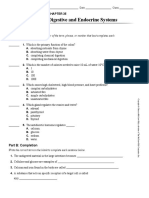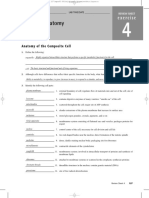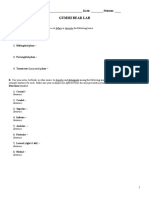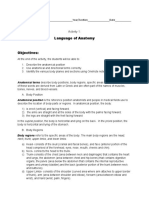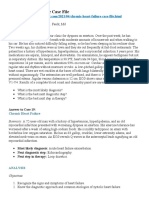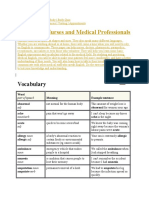37 1
37 1
Uploaded by
MoneymakerCopyright:
Available Formats
37 1
37 1
Uploaded by
MoneymakerOriginal Title
Copyright
Available Formats
Share this document
Did you find this document useful?
Is this content inappropriate?
Copyright:
Available Formats
37 1
37 1
Uploaded by
MoneymakerCopyright:
Available Formats
Name______________________________ Class __________________ Date ______________
Chapter 37 Circulatory and Respiratory Systems
Section 371 The Circulatory System (pages 943950)
This section describes the circulatory system and its functions.
Functions of the Circulatory System (page 943)
1. Why do large organisms require a circulatory system? Most of their cells are not in direct
contact with the environment, so they cannot rely on diffusion. Therefore, they need a circulatory
system to transport substances from one part of the organism to another.
2. What is a closed circulatory system? It is one that has a circulating fluid contained within
a system of vessels.
3. List the three components of the circulatory system.
a. Heart b. Blood vessels c. Blood
The Heart (pages 944946)
4. Is the following sentence true or false? The heart is composed almost entirely of
muscle. true
Match each heart structure with its description.
Structure Description
b 5. pericardium a. Thick layer of muscle in the walls of the heart
a 6. myocardium b. Sac of tissue that encloses and protects the heart
c 7. atrium c. Upper chamber of the heart
d 8. ventricle d. Lower chamber of the heart
9. The heart pumps about 72 times per minute.
10. Dividing the right side of the heart from the left side is a wall
called a(an) septum .
11. Is the following sentence true or false? The heart functions as four
Pearson Education, Inc. All rights reserved.
separate pumps. false
12. Complete the compare-and-contrast table.
THE CIRCULATORY SYSTEM
Name of Circulatory Pathway Side of Heart Involved Route Blood Follows
Pulmonary circulation Right side From heart to lungs
Systemic circulation Left side From heart to rest of body
13. What happens to blood when it reaches the lungs? Carbon dioxide leaves the blood and
oxygen is absorbed.
Guided Reading and Study Workbook/Chapter 37 359
Name______________________________ Class __________________ Date ______________
Chapter 37, Circulatory and Respiratory Systems (continued)
14. Why is the blood that enters the heart from the systemic circulation oxygen-poor?
The cells of the body have absorbed much of the oxygen the blood once contained and loaded
the blood with carbon dioxide.
15. Circle the letter of each sentence that is true about blood flow through the heart.
a. Blood enters the heart through the right and left atria.
b. Blood enters the heart through the right and left ventricles.
c. Blood flows from the ventricles to the atria.
d. Blood flows out of the heart through the right and left atria.
16. Flaps of connective tissue called valves prevent blood from flowing
backward in the heart.
17. Each heart contraction begins in a small group of cardiac muscle cells called the
sinoatrial node.
18. Cells that set the pace for the beating of the heart as a whole are also called the
pacemaker .
Blood Vessels (pages 946947)
19. Complete the concept map.
Types of Blood
Vessels
are
Pearson Education, Inc. All rights reserved.
Arteries Capillaries Veins
20. Circle the letter of each sentence that is true about arteries.
a. Most carry oxygen-poor blood. c. They have thin walls.
b. They can expand under pressure. d. The largest is the aorta.
21. Is the following sentence true or false? The smallest of the blood vessels are the
capillaries. true
22. What work is done in the capillaries? They bring nutrients and oxygen to the tissues and
absorb carbon dioxide and other waste products.
23. What keeps blood flowing toward the heart in the largest veins? Valves keep
blood flowing toward the heart.
360 Guided Reading and Study Workbook/Chapter 37
Name______________________________ Class __________________ Date ______________
Blood Pressure (pages 948949)
24. The force of blood on the walls of arteries is known as blood pressure .
25. Is the following sentence true or false? Blood pressure increases when the heart relaxes.
false
Match each type of blood pressure with the force it measures.
Type of Pressure Force It Measures
b 26. systolic a. Force of the blood when the ventricles relax
a 27. diastolic b. Force of the blood when the ventricles contract
28. Is the following sentence true or false? A typical blood pressure reading for a healthy
person is 140/80. false
29. How does the autonomic nervous system regulate blood pressure?
It releases neurotransmitters that cause the smooth muscles in blood vessel walls to
relax when blood pressure is too high or to contract when blood pressure is too low.
30. How do the kidneys regulate blood pressure? They remove more water from the blood and
thereby reduce blood volume when blood pressure is too high.
Diseases of the Circulatory System (pages 949950)
31. A condition in which fatty deposits build up on the walls of arteries is called
atherosclerosis .
32. High blood pressure also is called hypertension .
33. Is the following sentence true or false? High blood pressure increases the risk of heart
attack and stroke. true
34. Circle the letter of each sentence that is true about heart attack.
a. It is caused by atherosclerosis in the coronary arteries.
Pearson Education, Inc. All rights reserved.
b. It occurs when part of the heart muscle begins to die.
c. Its symptoms include nausea and chest pain.
d. It requires immediate medical attention.
35. Is the following sentence true or false? A stroke may be caused by a clot in a blood
vessel leading to the brain. true
36. List three ways of avoiding cardiovascular diseases.
a. Getting regular exercise
b. Eating a balanced diet
c. Not smoking
Guided Reading and Study Workbook/Chapter 37 361
You might also like
- MCQs On GITDocument3 pagesMCQs On GITsamuel waiswaNo ratings yet
- Lymphatic System RegentsDocument2 pagesLymphatic System Regentsabisantiago6131No ratings yet
- Endocrine System RegentsDocument3 pagesEndocrine System Regentsabisantiago6131No ratings yet
- Digestive and Endocrine Systems: Chapter TestDocument5 pagesDigestive and Endocrine Systems: Chapter TestJunior SencionNo ratings yet
- Final Written Lab Exam Form BDocument2 pagesFinal Written Lab Exam Form BErvin T MileNo ratings yet
- Digestion Regents QuestionsDocument3 pagesDigestion Regents Questionsabisantiago613175% (4)
- 131 MT - 1 Practice QuestionsDocument14 pages131 MT - 1 Practice QuestionsJay CaoNo ratings yet
- Unit 5 The Nervous System: PretestDocument5 pagesUnit 5 The Nervous System: PretestAmiel Richie BadiangNo ratings yet
- Material - Engleza - Medicina Anul 1, Sem 2Document58 pagesMaterial - Engleza - Medicina Anul 1, Sem 2Gabriella CoadaNo ratings yet
- Circulation WorksheetDocument6 pagesCirculation WorksheetKukresh TanveeraNo ratings yet
- Systems BookletDocument8 pagesSystems Bookletapi-383568582No ratings yet
- MCQs Physiology Cardiovascular 2017 MobDocument27 pagesMCQs Physiology Cardiovascular 2017 MobabuabdulqasimNo ratings yet
- Ap - Blood VesselsDocument14 pagesAp - Blood VesselsJustine May Balinggan DelmasNo ratings yet
- Cardiovascular-System-WorksheetDocument2 pagesCardiovascular-System-WorksheetashleyoNo ratings yet
- Biological Systems and Processes BookletDocument31 pagesBiological Systems and Processes Bookletapi-422428700100% (1)
- The Cell: Anatomy and Division: ExerciseDocument4 pagesThe Cell: Anatomy and Division: ExerciseMarielle SaymanNo ratings yet
- Anp2001 Test 1 Questions 2014Document7 pagesAnp2001 Test 1 Questions 2014Jerilee SoCute WattsNo ratings yet
- NERVOUS SYSTEM-quizDocument2 pagesNERVOUS SYSTEM-quizWengelu evan100% (1)
- Circulatory SystemDocument23 pagesCirculatory Systemhellwakeisbored12No ratings yet
- Muscular System Worksheet: I. Read The Passage and Answer The Questions That FollowDocument2 pagesMuscular System Worksheet: I. Read The Passage and Answer The Questions That FollowJulie Anne Bergado CortezNo ratings yet
- AP 1 Practice ExamDocument534 pagesAP 1 Practice Examerikasmith12290% (1)
- QuizDocument7 pagesQuizPhilip YansonNo ratings yet
- Endocrine ResonanceDocument51 pagesEndocrine ResonanceEkta ManglaniNo ratings yet
- Cardiovascular & Respiratory SystemDocument17 pagesCardiovascular & Respiratory Systemjmunozbio@yahoo.comNo ratings yet
- Nervous System Exam QsDocument12 pagesNervous System Exam QsV1 wolvoNo ratings yet
- Mid-Unit CH 12 Test A KEYDocument5 pagesMid-Unit CH 12 Test A KEYcmillica1176No ratings yet
- Muscular System OutlineDocument6 pagesMuscular System Outlineapi-294104473No ratings yet
- Nervous System ReviewDocument6 pagesNervous System Reviewtherenam825No ratings yet
- Human Body System Regents QuestionsDocument11 pagesHuman Body System Regents Questionsabisantiago613125% (4)
- Student Exploration: Circulatory SystemDocument4 pagesStudent Exploration: Circulatory SystemAndreNo ratings yet
- Gummy Bear LabDocument3 pagesGummy Bear Labapi-326013029No ratings yet
- Topic 9 Cardiovascular SystemDocument36 pagesTopic 9 Cardiovascular SystemAlejandra CastilloNo ratings yet
- Quiz 1 Orientation To The Human BodyDocument3 pagesQuiz 1 Orientation To The Human BodyLisa HatchNo ratings yet
- Digestive System PowerpointDocument19 pagesDigestive System Powerpointapi-277974939No ratings yet
- Vein Vs ArteryDocument4 pagesVein Vs ArterySaarwin MuruganNo ratings yet
- Rajarshi Shahu JR Science College, Latur Screening Test - 2019 Syllabus: Physics 1 Motion 2Document7 pagesRajarshi Shahu JR Science College, Latur Screening Test - 2019 Syllabus: Physics 1 Motion 2Dr. Laxman RautNo ratings yet
- Photosynthesis TestDocument2 pagesPhotosynthesis TestCelle RichNo ratings yet
- Biology: Circulation and Cardiovascular SystemsDocument59 pagesBiology: Circulation and Cardiovascular SystemsIain Choong WKNo ratings yet
- Circulatory System Review Worksheet KEYDocument7 pagesCirculatory System Review Worksheet KEYJerilee SoCute WattsNo ratings yet
- Unit Test Cell StructureDocument5 pagesUnit Test Cell StructureAina FauziaNo ratings yet
- Chapter 15 - URINARY SYSTEM PDFDocument8 pagesChapter 15 - URINARY SYSTEM PDFRishelle Mae Miñoza PilonesNo ratings yet
- Muscular System WorksheetDocument1 pageMuscular System Worksheetapi-238647540No ratings yet
- Cardiovascular System TestDocument28 pagesCardiovascular System TestDani Anyika100% (1)
- Exam CirculatoryDocument1 pageExam CirculatoryLuisa RamosNo ratings yet
- Review 4 Chap 12-16Document21 pagesReview 4 Chap 12-16j_docsNo ratings yet
- Sciences 6 - Sample PagesDocument12 pagesSciences 6 - Sample PagesLili Muñoz Mendoza100% (1)
- Chapter 12 Neural TissueDocument15 pagesChapter 12 Neural TissueKatherine De San AgustinNo ratings yet
- SkeletalSystemNotes PDFDocument2 pagesSkeletalSystemNotes PDFAnsh Tanwar100% (1)
- Chapter 3: Cells: Shier, Butler, and Lewis: Hole's Human Anatomy and Physiology, 13Document9 pagesChapter 3: Cells: Shier, Butler, and Lewis: Hole's Human Anatomy and Physiology, 13Kenken MijaresNo ratings yet
- Week 1 in Video Quizzes PDFDocument10 pagesWeek 1 in Video Quizzes PDFIsthafa AlanisaNo ratings yet
- Integumentary System WorksheetDocument4 pagesIntegumentary System WorksheetLAQUESHA MAJORS0% (1)
- Chapter 3 Cells and TissuesDocument4 pagesChapter 3 Cells and TissuesClarisse Anne QuinonesNo ratings yet
- Anatomy - Chapter 3 Tissues WSDocument6 pagesAnatomy - Chapter 3 Tissues WSOlalekan OyekunleNo ratings yet
- Final Written Lab Exam Form ADocument4 pagesFinal Written Lab Exam Form AErvin T MileNo ratings yet
- Short Answer: Essentials of Anatomy and Physiology, 9e (Marieb) Chapter 11 The Cardiovascular SystemDocument23 pagesShort Answer: Essentials of Anatomy and Physiology, 9e (Marieb) Chapter 11 The Cardiovascular SystemRafael CastilloNo ratings yet
- Language of Anatomy: Name - Year/Section - DateDocument11 pagesLanguage of Anatomy: Name - Year/Section - DateKaye ViolaNo ratings yet
- Nervous Coloring Packet - 2019Document14 pagesNervous Coloring Packet - 2019CIANNA MARQUEZNo ratings yet
- Chapter 1 AnaPhy Notes - ReviewerDocument6 pagesChapter 1 AnaPhy Notes - ReviewerDanielle LeighNo ratings yet
- Blood Vessel and Lymphatic Lab OutputDocument12 pagesBlood Vessel and Lymphatic Lab OutputDayledaniel SorvetoNo ratings yet
- Biology C - Lesson 1 - Circulatory SystemDocument46 pagesBiology C - Lesson 1 - Circulatory SystemMuhammad Azrie0% (1)
- The Heart Activity 3 PDFDocument4 pagesThe Heart Activity 3 PDFbiancaNo ratings yet
- Test Questions Internal MedicineDocument13 pagesTest Questions Internal MedicineJo Anne86% (7)
- Annotated-1.2.4 Histology Part 1Document2 pagesAnnotated-1.2.4 Histology Part 1angie.hernandezcarNo ratings yet
- CBSE Class 12 Physical Education Previous Year Question Paper 2018Document18 pagesCBSE Class 12 Physical Education Previous Year Question Paper 2018laraviNo ratings yet
- Congestive Heart FailureDocument37 pagesCongestive Heart FailurePierre Aseron ManuelNo ratings yet
- DLL 4 - Body OrganssDocument4 pagesDLL 4 - Body OrganssAdor IsipNo ratings yet
- PacemakerDocument48 pagesPacemakersoniya josephNo ratings yet
- Ekg Morphology PDFDocument1 pageEkg Morphology PDFMiguel Cuevas DolotNo ratings yet
- Dated:: I Hereby Declare That The Project Titled "Effect of Brand On CustomerDocument75 pagesDated:: I Hereby Declare That The Project Titled "Effect of Brand On CustomerParshant GargNo ratings yet
- Atrial FibrillationDocument14 pagesAtrial FibrillationNur Atiqah Zainal100% (1)
- Assessment of The Heart and Neck VesselsDocument7 pagesAssessment of The Heart and Neck Vesselsclyde i amNo ratings yet
- Chronic Heart Failure Case FileDocument2 pagesChronic Heart Failure Case Filehttps://medical-phd.blogspot.comNo ratings yet
- Chapter 12 - Cardiovascular EmergenciesDocument47 pagesChapter 12 - Cardiovascular EmergenciesJunx TripoliNo ratings yet
- Ch:10 Transport of Substances in Animals and Plants WorksheetDocument2 pagesCh:10 Transport of Substances in Animals and Plants WorksheetvienergresourcesNo ratings yet
- English Nursing 2Document22 pagesEnglish Nursing 2Anonymous fwaG1cNudUNo ratings yet
- Cardiology OSCEsDocument85 pagesCardiology OSCEsMed StudentNo ratings yet
- Cardiology MCQDocument7 pagesCardiology MCQNesma Adel100% (1)
- Sri Lankan Biology Olympiad Model Questions 2009: InstructionsDocument6 pagesSri Lankan Biology Olympiad Model Questions 2009: InstructionsScience Olympiad BlogNo ratings yet
- Elective II FinalsDocument15 pagesElective II FinalsAljon Dofeliz LlamasNo ratings yet
- G9 Circulatory SystemDocument42 pagesG9 Circulatory Systeminah krizia lagueNo ratings yet
- Igcse Biology Revision Finale!!Document143 pagesIgcse Biology Revision Finale!!sohaila ibrahim100% (1)
- Practice Questions 1-9 (FINAL)Document38 pagesPractice Questions 1-9 (FINAL)Riz Austria RN0% (1)
- Final Checklist For Osce 2022-2023Document8 pagesFinal Checklist For Osce 2022-2023Ahmed SaidNo ratings yet
- Ebstein's AnomalyDocument7 pagesEbstein's AnomalyRJMNo ratings yet
- 316 RevalidaDocument14 pages316 RevalidaPAOLA LUZ CRUZNo ratings yet
- TachycardiaDocument2 pagesTachycardiaًNo ratings yet
- OET Speaking 1Document3 pagesOET Speaking 1ejazzNo ratings yet
- MedicationsDocument30 pagesMedicationsvamshidhNo ratings yet
- The Immune System - Test QuestionsDocument4 pagesThe Immune System - Test QuestionsflorinNo ratings yet
- Tetralogy of Fallot Everything You Wanted To Know But Were Afraid To AskDocument8 pagesTetralogy of Fallot Everything You Wanted To Know But Were Afraid To AsksofiaNo ratings yet



